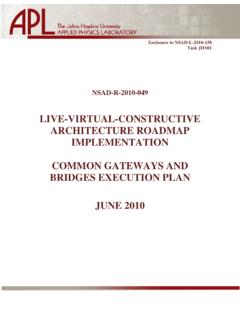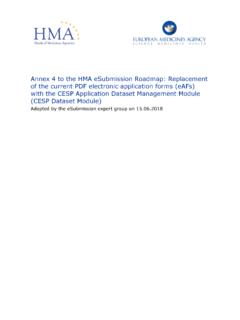Transcription of NSAD-R-2010-043: Live-Virtual-Constructive Architecture ...
1 - Enclosure to: NSAD-L-2010-144 JHS01 NSAD-R-2010-043 Live-Virtual-Constructive Architecture roadmap implementation , common capabilities - common Data Storage Formats implementation Plan Technical Report May 2010 NSAD-R-2010-043 Live-Virtual-Constructive Architecture roadmap implementation , common capabilities - common Data Storage Formats implementation Plan Technical Report May 2010 FOR: Joint Training Integration and Evaluation Center 12000 Research Parkway, Suite 300 Orlando, FL 32826 BY: Johns Hopkins University - Applied Physics Laboratory 11100 Johns Hopkins Road Laurel, MD 20723 This page intentionally left blank. LVC common capabilities : common Data Storage Formats implementation Plan JHU/APL Team Title Name Organization Team Lead Dr.
2 Katherine L. Morse JHU/APL Program Manager Dr. James Coolahan JHU/APL Team SME Ryan Brunton JHU/APL Team SME Terri Morgan JHU/APL Team SME Bill Riggs JHU/APL Team SME Roy Scrudder ARL:UT LVC common capabilities : common Data Storage Formats implementation Plan This page intentionally left blank. LVC common capabilities : common Data Storage Formats implementation Plan Page v TABLE OF CONTENTS EXECUTIVE SUMMARY .. ES-1 1 INTRODUCTION .. 1-1 GOALS AND OBJECTIVES .. 1-1 BACKGROUND .. 1-1 History of DoD Data Standardization .. 1-1 M&S Data Standardization Challenge Multiple Representations .. 1-3 Standards Stewardship and the M&S Community .. 1-3 common Patterns for Solving Data Interoperability Problems with Standards .. 1-4 Base State: Multiple Producer and Consumer Formats, without Mediation .. 1-4 Fully Converged: Single Data Format .. 1-5 Partially Converged: Mediation Format(s) Exist.
3 1-6 SCOPE .. 1-7 METHODOLOGY .. 1-8 2 CURRENT STATE AND FEASIBILITY ASSESSMENT .. 2-1 GEOSPATIAL DATA .. 2-2 MANMADE ENVIRONMENTAL 2-6 UNIT ORDER OF BATTLE/FORCE STRUCTURE .. 2-9 ELECTRONIC ORDER OF 2-12 PLATFORM/WEAPONS PERFORMANCE AND/OR CHARACTERISTICS .. 2-14 PLANS/SCENARIOS .. 2-15 BEHAVIOR .. 2-18 LOGISTICS .. 2-21 EVENT RESULTS .. 2-22 3 implementation PLAN .. 3-1 QUESTIONNAIRE RESPONSES .. 3-1 What and How to Standardize .. 3-1 Priorities Based on Community 3-2 FEASIBILITY AND PRIORITIES .. 3-4 STRATEGIES FOR EACH FORMAT CATEGORY .. 3-7 APPENDIX A: REFERENCES .. A-1 APPENDIX B: CURRENT STATE .. B-1 APPENDIX C: QUESTIONNAIRE RESULTS .. C-1 APPENDIX D: COI COORDINATION MATRIX .. D-1 APPENDIX E: NAMESPACE COORDINATION MATRIX .. E-1 APPENDIX F: ANALYSIS OF NEED AND DIFFICULTY .. F-1 APPENDIX G: ABBREVIATIONS AND ACRONYMS .. G-1 LVC common capabilities : common Data Storage Formats implementation Plan Page vi LIST OF FIGURES Figure 1-1: Base State: Multiple Producer and Consumer Formats, without Mediation.
4 1-5 Figure 1-2: Fully Converged: Single Data Format .. 1-6 Figure 1-3: Partially Converged: Mediation Format(S) Exist .. 1-7 Figure 3-1: Level at which to Standardize Data Formats .. 3-1 Figure 3-2: How/Where to Standardize Data Formats .. 3-2 Figure 3-3: Recommendations Graph .. 3-4 Figure C-1: Participants Organization Type .. C-9 Figure F-1: Needs and Difficulty F-3 LVC common capabilities : common Data Storage Formats implementation Plan Page vii LIST OF TABLES Table ES-1: implementation Plans .. ES-2 Table 2-1: Geospatial Data Summary .. 2-5 Table 2-2: Manmade Environmental Features Summary .. 2-8 Table 2-3: UOB 2-11 Table 2-4: EOB Summary .. 2-13 Table 2-5: C&P Data Summary .. 2-15 Table 2-6: Plans/Scenarios Summary .. 2-17 Table 2-7: Behavior Summary .. 2-20 Table 2-8: Logistics Summary .. 2-22 Table 2-9: Event Results Summary.
5 2-24 Table 3-1: Questionnaire Results .. 3-3 Table 3-2: Difficulty Summary .. 3-5 Table B-1: Synthetic Natural Environment Formats .. B-3 Table B-2: Manmade Environmental Feature Formats .. B-17 Table B-3: Unit Order Of Battle/Force Structure Formats .. B-21 Table B-4: Electronic Order Of Battle/Network Formats .. B-24 Table B-5: Platform/Weapons Performance and/or Characteristics Formats .. B-27 Table B-6: Plans/Scenario Formats .. B-29 Table B-7: Behavior Formats .. B-36 Table B-8: Logistics .. B-37 Table B-9: Event Results .. B-39 Table C-1: Participant Roles .. C-10 Table C-2: Reusable Tools and common Data Storage Formats .. C-11 Table C-3: Geospatial Data .. C-12 Table C-4: Manmade Environmental Features: .. C-13 Table C-5: Unit Order Of Battle Data .. C-14 Table C-6: Electronic Order Of Battle/Network .. C-15 Table C-7: Weapons Performance and Characteristic Data.
6 C-16 Table C-8: Plans And Scenario Data .. C-17 Table C-9: Behavior Data .. C-18 Table C-10: Logistics Data .. C-19 Table C-11: Event Results Data .. C-20 Table C-12: Data Standardization .. C-21 Table C-13: Data Formats Used .. C-22 Table C-14: Organizations Responsible for Data Standardization .. C-24 Table D-1: GIG COI Coordination Cross-Reference Matrix .. D-1 Table F-1: Detailed Need and Difficulty Calculation .. F-1 LVC common capabilities : common Data Storage Formats implementation Plan Page viii This page intentionally left blank. LVC common capabilities : common Data Storage Formats implementation Plan Page ES-1 EXECUTIVE SUMMARY The Live-Virtual-Constructive Architecture roadmap (LVCAR) report recommended actions to promote the sharing of tools, data, and information across the Enterprise and to foster common formats and policy goals to promote interoperability and the use of common Modeling and Simulation (M&S) capabilities .
7 One of the recommended actions was to examine different data storage formats used across the various architectures to determine the feasibility of creating a set of Architecture -independent formats. Such formats would be used for storage of classes of data in order to mitigate the cost and schedule impacts of database conversion, minimize conversion errors, and improve consistency across Live-Virtual-Constructive (LVC) architectures. The focus of this effort is limited to data interchange formats and applicable standards where the data is persistent, , in stored datasets. The study team identified nine (9) categories of data storage formats, based on expertise and feedback received at the LVC common capabilities Workshop at The Johns Hopkins University Applied Physics Laboratory (JHU/APL) in November 2009 and questionnaires administered in person at the Interservice/Industry Training, Simulation and Education Conference (I/ITSEC) 2009 and online.
8 This stakeholder feedback was used to assess the priority for rationalization of data storage formats for each category. The team examined the contents of eight (8) metadata standards registries, catalogs and repositories for each category identified. These sources included the Department of Defense (DoD) Metadata Registry, DoD Information Technology Standards and Profile Registry (DISR), the North Atlantic Treaty Organization (NATO) and DoD M&S Standards Profile, and the Acquisition Streamlining and Standardization Information System (ASSIST) database, in addition to privately maintained source materials. For each of the nine (9) format categories, a list of applicable formats was compiled and characterized in terms of currency, openness, maturity, and applicability as a source (producer), interchange (mediation) and executable (consumer) data format.
9 This information was used to assess the difficulty of rationalizing formats within each category. In addition, the team developed a strategy for each of the nine categories by evaluating the feasibility of moving to a state of greater reuse via a combination of: (1) reduction in the number of formats used in each category; (2) standardization of formats in each category if no standards exist; (3) increased adoption of mediation formats to reduce translation errors; and (4) creation or engagement with category-specific communities of interest (COIs). Using this prioritization approach, the standardized formats should be pursued in the following order: Priority 1 Manmade features Event results LVC common capabilities : common Data Storage Formats implementation Plan Page ES-2 Priority 2 Geospatial Priority 3 Unit Order of Battle (UOB) Plans/scenarios Priority 4 Platform/Weapons performance Behavior Priority 5 Electronic Order of Battle (EOB)/network Logistics The team identified the following list of general engagement strategies for improving the state of any category.
10 Engage with ongoing efforts to ensure they include LVC-specific requirements, Establish forum/process for mediating between dissenting communities, Initiate activity to bring key stakeholders together to develop format where no clear viable solution currently exists, Accelerate promising, but slow, ongoing efforts, Enable management/cooperation changes, and Monitor until sufficient meaningful direction emerges. Table ES-1 consolidates the recommendations, feasibility, and priority with these general strategies to provide specific strategies and timelines for each category. Table ES-1: implementation Plans Category Strategy Timeline Manmade features (Priority 1) Engage with ongoing efforts to ensure they include LVC-specific requirements: Determine M&S-specific set of requirements for three dimensional (3D) manmade features representation. Work with existing standards bodies to ensure requirements not yet met by their specifications are incorporated in the next iteration (Khronos Group - COLLADA1, Open Geospatial Consortium (OGC) CityGML, Web3D - X3D).










